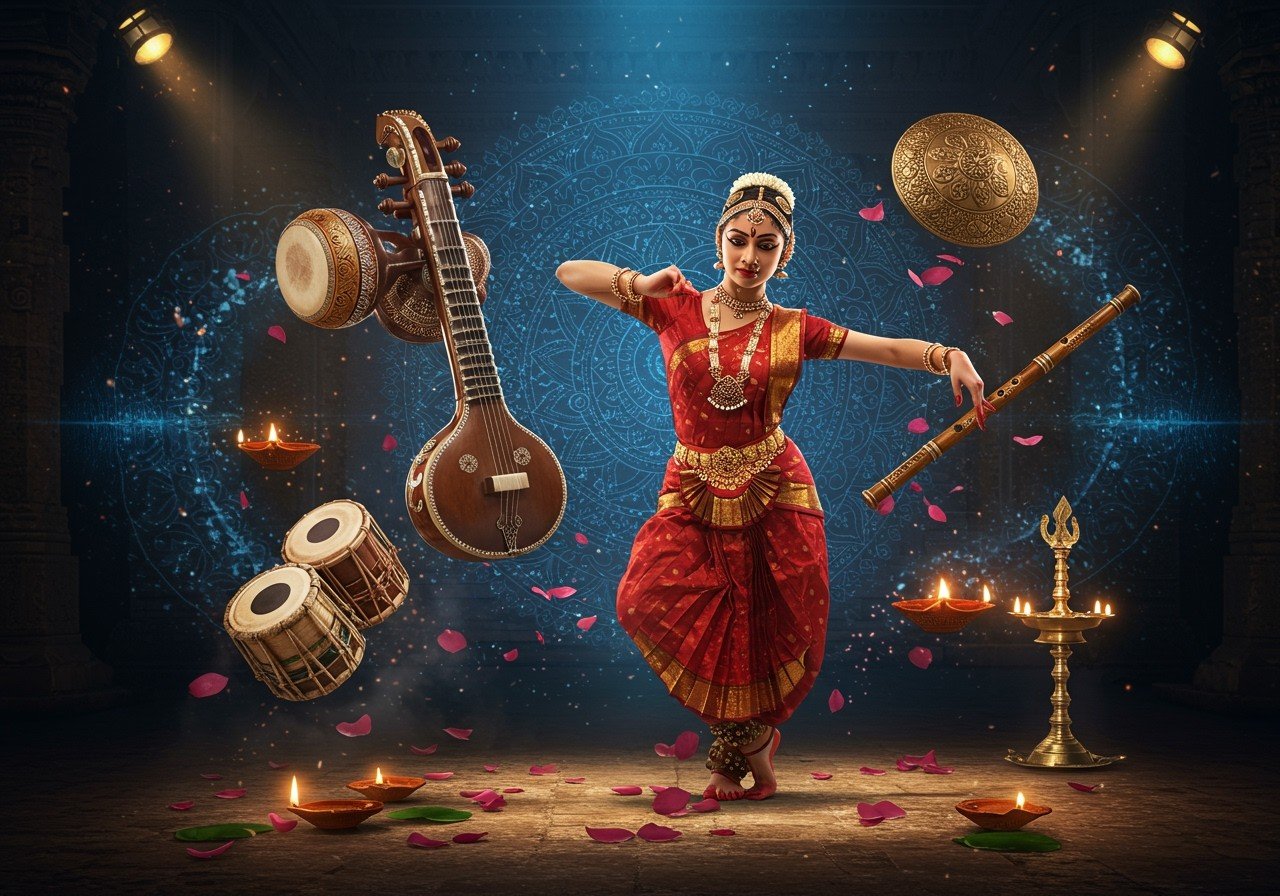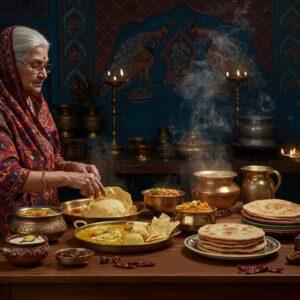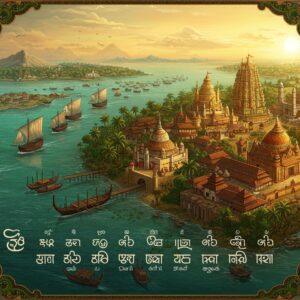The Vital Role of Music in Indian Classical Dance

Indian classical dance, a captivating art form passed down through generations, is intrinsically linked to music. Each dance style possesses unique musical elements that convey stories and emotions, making performances truly mesmerizing. The rich history of Indian classical dance is steeped in spiritual and religious significance, adding depth to every graceful movement.
Music’s Significance in Shaping Indian Classical Dance
Music is the heart of Indian classical dance, guiding both rhythm and emotion. It dictates the tempo, provides cues for dancers, and ensures seamless performances. Tala (rhythm) and Raga (melody) are fundamental elements that structure the dance. Dancers and musicians collaborate closely, often improvising to enhance the performance. The lyrics of the songs narrate tales or express feelings that dancers embody through their movements.
Essential Instruments in Indian Classical Dance
Indian classical dance is a harmonious blend of rhythm, melody, and grace, and instruments play a crucial role in bringing these elements to life. They create the backdrop against which dancers weave their stories, each instrument adding its unique voice to the performance.
- Tabla: This two-piece drum generates intricate rhythms, vital for accentuating footwork. Played with fingers and palms, the tabla adds a dynamic percussive layer to the performance, responding to the dancer’s movements with precision.
- Pakhawaj (Mridangam): This barrel-shaped drum adds depth and resonance, particularly prominent in Kathak. Its rich tones create a foundation for the dance, enhancing the rhythmic complexity and emotional depth.
- Sarangi: A string instrument with a sound remarkably close to the human voice, the sarangi injects emotional depth into the performance. Its melancholic tones can evoke a wide range of feelings, adding a poignant layer to the storytelling.
- Sitar: With its numerous strings, the sitar contributes a rich tapestry of sound, creating a vibrant and intricate soundscape. Its melodic lines intertwine with the dance, enhancing the emotional narrative.
- Flute (Bansuri): This wind instrument delivers fluid and expressive tones, often featured in Kathak, Bharatanatyam, and Odissi. The bansuri’s melodic phrases add a layer of fluidity and grace, complementing the dancer’s movements.
- Tanpura: Providing a continuous drone, the tanpura ensures harmony and assists dancers in maintaining intonation. This constant backdrop creates a stable musical environment, allowing the other instruments and the dancer to shine.
- Harmonium: This instrument delivers harmonic support and rhythm, underpinning the dancer’s movements with a consistent melodic structure. It helps create the musical framework for the performance.
- Manjira: These small hand cymbals inject rhythmic complexities, enriching the overall sonic texture. Their delicate yet precise sounds highlight specific movements and transitions in the dance.
- Sarod: A stringed instrument known for its resonant tones, the sarod enhances the melodic foundation of the performance. Its rich, deep sounds create a sense of grandeur and depth.
- Veena: Employed for its resonant and soulful tones, the veena establishes a melodic foundation for the dance. Its ancient and revered sound adds a layer of tradition and spirituality to the performance.
- Shehnai: This wind instrument contributes fluid and expressive tones to the melodic palette, enhancing the emotional narrative. Its unique sound can evoke a sense of joy, sorrow, or longing, adding another dimension to the storytelling.
- Ghatam: A percussion instrument crucial for its rhythmic complexities, the ghatam provides a unique textural element. Its earthy tones add a grounded and percussive layer.
- Duffli: Used in Kathak dance, the duffli provides rhythmic accompaniment. Its distinct percussive sound adds a folk element, enriching the rhythmic tapestry of Kathak.
- Dholak: Predominantly a folk instrument utilized in qawwali, kirtan, and North Indian folk music, the dholak historically played a significant role in classical dance. Its double-headed design allows for a wide range of sounds.
Other instruments sometimes used include the Manipuri Pung (a barrel-shaped drum), conch shells, and trumpet-like horns, adding regional flavors. The Natya Shastra categorizes these instruments into four groups: Tata Vadya (stringed), Avanadh Vadya (percussion), Sushira Vadya (wind), and Ghana Vadya (solid). Each category contributes distinct textures and vibrancy, showcasing the diverse and rich musical landscape of Indian classical dance.
How Poojn.in Supports Indian Classical Dance & Music
Poojn.in offers a curated selection of products to enhance the spiritual and cultural aspects of Indian classical dance and music. For performances incorporating puja elements, we offer authentic Pancha Ratna sets – the five precious stones associated with Goddess Lakshmi, adding auspiciousness to dance performances, particularly in Carnatic music. Poojn.in ensures these sacred items are genuine and ethically sourced.
Our collection also features puja items for stage performances, traditional bells, and ritual items used in classical dance. Performers and teachers incorporating traditional elements can rely on Poojn.in for verified, high-quality items with convenient online ordering and pan-India delivery. All products are accompanied by detailed usage instructions and information on their cultural significance.
Visit Poojn.in or contact our customer service team for assistance in selecting the right items for your classical dance and music needs.
Celebrating the Synergy of Dance and Music
In Indian classical dance, music is not merely an accompaniment; it is the soul of the performance. Every instrument, from the rhythmic pulse of the tabla to the soulful strains of the sarangi, plays a crucial role in creating an unforgettable experience. These instruments weave together a beautiful tapestry of sound, enriching the dance and revealing its essence.
Understanding these instruments allows us to appreciate the intricate artistry and deep cultural roots of Indian classical dance. They highlight the harmony between dance and music, where each element is essential and celebrated. As we immerse ourselves in the melodies and rhythms, we witness a timeless tradition that continues to inspire and connect us to our heritage.
Whether attending a live performance or exploring recordings, let the music guide you into the enchanting world of Indian classical dance, where every note and every beat tells a story.
Frequently Asked Questions about Indian Classical Dance, Music, and Instruments
What are the primary types of Indian classical dance? There are eight main forms: Bharatanatyam, Kathak, Kathakali, Kuchipudi, Manipuri, Mohiniyattam, Odissi, and Sattriya.
Which instruments are commonly used? Instruments like the tabla, mridangam, veena, sitar, flute, and harmonium are frequently featured in Indian classical dance performances.
What kinds of songs are used? Indian classical dance often uses songs based on ragas, with lyrics narrating mythological stories or expressing emotions.
How does music enhance the dance? Music sets the rhythm, creates the mood, and guides the dancer’s movements and expressions, conveying the story effectively. It is the backbone of the performance, setting the emotional tone and providing structure.
Why is rhythm important? Rhythm is crucial for maintaining timing, synchronizing movements, and expressing the intended emotion or story. It is the foundation upon which the dancer builds their performance.
Can the dance be performed without music? While possible, music significantly enhances the depth and emotion of the dance, making the performance far more engaging and expressive.


